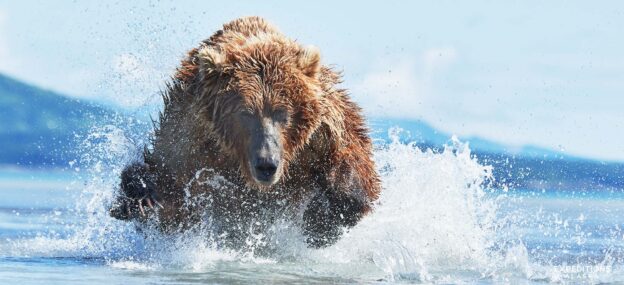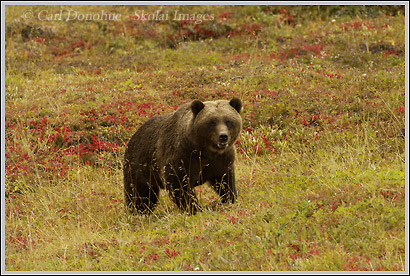Hey Folks,
Bear Attack in Wyoming
I’ve been reading a little about a recent case of a bear attack, this time in Yellowstone National Park, Wyoming. Fortunately, the fellow who was mauled is alive. Here’s one version of the story.
A lot of discussion has focused on this incident on various nature photography forums. Much of that discussion revolves around the potential for this kind of thing to be a vehicle for new, tighter regulations brought into place by the National Parks’ Service, placing ever tighter restrictions on photographers and the activities they engage.
My Experience
I’ve been photographing bears in the wild a long time. Probably longer than most folks. I don’t know all there is about grizzly bears, but I do know more than most. I spend weeks on end every year photographing grizzly bears, hiking and backpacking in bear country, and talking to researchers and other naturalists who know bears.
So I’ve got my bear bones.
Points of Discussion About Bear Attacks
1. We Hope the Victim/s are OK
While I think that’s a worthy discussion, hopefully it’s not the be sole focus of our concern. Firstly, I hope the guy’s OK. I’ve been close enough to many grizzly bears that I can barely (now there’s a great pun) imagine how terrible it must be to be mauled by one.
2. Don’t Harm the Bear
Secondly, I hope the park service folks don’t harm the bear. I think, from what I’ve read, that would be an entirely inappropriate response, and it appears, from what I’ve read on it so far, that common sense will prevail and they’ll leave the bear alone. There doesn’t seem to be anything in the reports here indicating that this is likely to happen, thank goodness.
There are NO cases, ever, of a bear suddenly becoming a ‘maneater’ because it attacked someone. They’re not big cats. It doesn’t happen.
3. Case Against Tightening Rules
Thirdly, I don’t see any real reason to bring in tighter restrictions on photographers for this kind of thing. From what I’ve read and heard so far, it seems what this fellow was doing was outside the bounds of the law anyway. Tightening rules and legislature doesn’t work for folks who don’t follow the rules to begin with.
4. Don’t Critique What We Don’t Know
Lastly though, I want to make a few comments about some of the posts I’ve run across from other photographers, many of whom spend very little time photographing wild animals in the wild.
It’s very easy to be critical of someone when something goes awry. And when dealing with wild, and wildness, things WILL go awry. It’s part of what makes wilderness so beautiful. It’s completely out of our control, and learning to be comfortable with that is a very, very cool process.
Case Study in Bear Attacks; A Personal Story
Here’s a great example.
I was out hiking one afternoon in Wrangell-St. Elias National Park. I was way in the backcountry, an area accessible only via a flight in a bush plane. This particular afternoon I was hiking alone, as the rest of the party decided to stay back at camp and rest.
So I’m hiking along the tundra by myself, stopping to photograph everything from flowers and Alaska cottongrass to songbirds and grand scenics.
I notice movement out of the corner of my eye, and I look down the hill to see a grizzly bear, slowly making his way up the ridge towards me (yes, the bear photograph at the top of this post).
There’s absolutely nowhere I can go to get away.
Nor could I travel quick enough if I chose to try.
Like any photographer, I take a few photos, all the while hoping the bear decides to leave me alone. Soon enough it becomes apparent to me that this bear is not going to leave me alone, but is very intentionally approaching me.
What Do You Do When a Bear Approaches?
Now the books tell me, in this situation, to keep calm, which fortunately I’m able to to (though my heartbeat’s riding about 525 bpm – close to maxxed out).
With one hand I grab my tripod and camera rig, hold it aloft, and the other I raise above my head, simultaneously speaking aloud, in the hopes the bear recognizes the sound of a human voice and decides to go elsewhere for dinner.
I do exactly what I’m supposed to do.
What Does the Bear Do?
What happens is the bear increases his pace, and becomes more focused on myself. Suddenly, I’m staring at a 400 pound barrel of fur and muscle, hurtling across the tundra towards me at 35 miles per hour.
Bears Are Fast
Really fast.
What amazed me perhaps the most was the incredible fluidity of the bear. Transformed from a lumbering giant, it suddenly had become this sinuous and supple brown powerhouse, moving over the rolling terrain as graciously as a big cat might.
I hoisted a can of bear spray from my pocket, armed it, and watched the bear. For a split second it struck me as absurd, holding a can of pepper spray as defense against a charging grizzly bear.
He came within maybe 25 yards of me before veering to one side, then raced away, directly down the hill he’d just clambered up, looking back over his shoulder as though he feared I might be chasing him (I didn’t, I was rooted to the spot).
What Might Have Happened?
My point here is not what happened to me. It’s what could so easily have happened.
The bear could very easily have not veered away, and I’d now be fragments of bone and decomposed tissue on the tundra.
The key point here is that what happened was entirely up to the bear.
Whilst this time it worked out well for the photographer, the result could’ve so easily been very different, and there wasn’t much I could do about it.
Technically, I wasn’t doing anything “wrong”, other than perhaps being alone on the tundra – most studies and experts advise that bear attacks are less frequent when people are traveling together, and almost non-existent when there are 3 or more people traveling together.
Traveling Alone in Bear Country
I guess I’m willing to take that chance, however, as I enjoy, indeed I value, walking in the wilderness alone. Even when out hiking as a group, people often split up and travel solo at times, for various reasons.
There’s simply no way to be rid of the chance of being attacked by a bear when we’re in bear country.
There’re countless ways we can minimize those chances, but they’re never zero.
If we want bears in the woods, and we want to be in the woods, then we carry the chance of being attacked by a bear. And it doesn’t matter how careful we are, how closely we adhere to park regulations, how wise we are, sometimes sh** happens.
Cheers
Carl


Carl, you got my heartbeat up just reading this. I am glad the bear made the right decision, and granted you the gift of a great shot as well.
Hey Mark
I’m pretty glad the bear decided as he did, too. 🙂
Thanks for your post.
Cheers
Carl